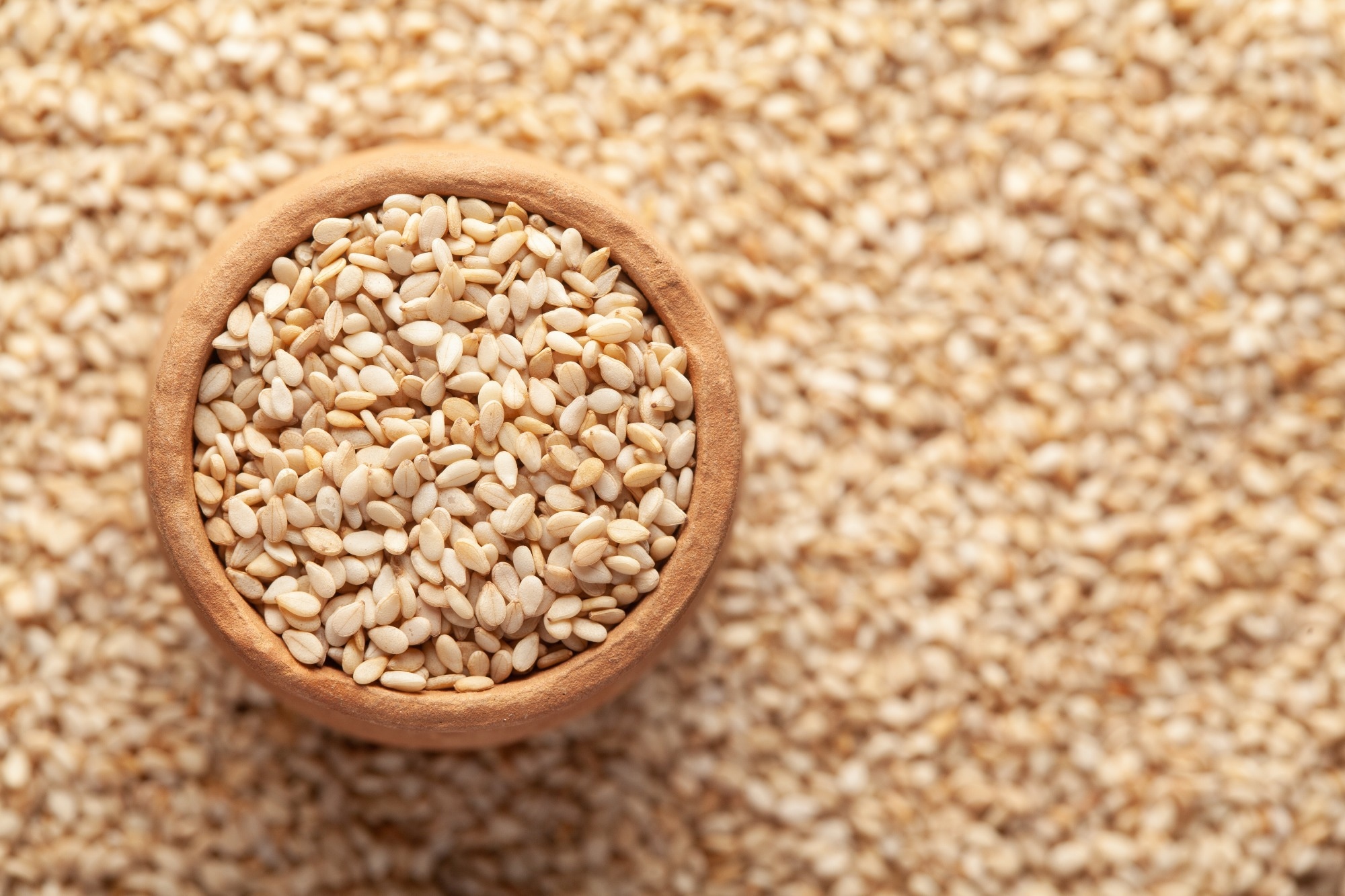A recent Nutrients study screened antibacterial peptides obtained from sesame protein using in silico and in vitro methods to explore their antibacterial activity against Escherichia coli and Staphylococcus aureus.
 Study: Antibacterial Effect of Sesame Protein-Derived Peptides against Escherichia coli and Staphylococcus aureus: In Silico and In Vitro Analysis. Image Credit: ELAKSHI CREATIVE BUSINESS / Shutterstock.com
Study: Antibacterial Effect of Sesame Protein-Derived Peptides against Escherichia coli and Staphylococcus aureus: In Silico and In Vitro Analysis. Image Credit: ELAKSHI CREATIVE BUSINESS / Shutterstock.com
Background
Antibacterial peptides (ABPs) are endogenous in many different organisms, have a distinctive α-helix or β-fold, and comprise between five and 50 amino acids. ABPs are amphiphilic, thus indicating that they possess both hydrophobic and hydrophilic ends. Previous research has shown that ABPs can target the cytoplasmic membrane and lead to the removal of microbes and cancer cells.
Sesamum indicum L., or sesame, is a commonly cultivated oilseed crop rich in sesame protein levels within the 17-40% range. In vitro and in vivo studies have demonstrated that sesame seed peptides exhibit various therapeutically relevant properties, including blood lipid reduction, antioxidants, diabetes resistance, and anti-aging; however, the antibacterial activity of sesame peptides remains unclear.
About the study
The present study aimed to identify sesame protein-derived peptide inhibitors capable of interacting with the active site residues of dihydropteroate synthase (DHPS), a crucial enzyme in the folate pathway.
Bioinformatics tools were deployed to focus on two significant sesame proteins, including 2S seed storage protein 1 (Q9XHP1) and 11S globulin seed storage protein 2 (Q9XHP0). The selected AMPs were synthesized in vitro, and their minimum inhibitory concentration (MIC) was measured.
Hybrid enzyme hydrolysis can lead to more potent peptides than single enzyme-performed hydrolysis. As a result, three proteases commonly present in the gastrointestinal tract were elected for simultaneous enzyme digestion.
The analysis involved peptides comprising two to 15 amino acid residues, as well as the evaluation of their toxicity, physicochemical properties, and allergenicity.
Key findings
Non-sensitizing, non-toxic, and positively charged peptides were selected for molecular docking screening, as a higher charge implies greater antimicrobial activity against Gram-positive and Gram-negative pathogens.
Ala-Gly-Gly-Val-Pro-Arg and Ser-Thr-Ile-Arg peptides inhibited the growth of both Gram-positive Staphylococcus aureus and Gram-negative Escherichia coli. The precise amino acid sequences of the two sesame proteins were ascertained using the uniport database. Through virtual enzyme digestion, 229 endogenous peptides were obtained.
Recent studies have identified the short peptide Trp-Lys, which is a potent inhibitor of Mycobacterium tuberculosis that can bind to both sulfa drug-binding regions and pteridine monophosphate, thus making this agent less vulnerable to drug-resistant mutations. Due to this property, Trp-Lys was selected as a positive control. Importantly, Ser-Thr-Ile-Arg and Ala-Gly-Gly-Val-Pro-Arg outperformed Trp-Lys, thereby demonstrating their viability as ABPs.
The net positive charge in peptides facilitated their antimicrobial activity, as peptides with a net positive charge can react with the oppositely charged bacterial membrane phospholipids, which leads to enhanced membrane permeability and cell death.
Previous studies have elucidated the association between antimicrobial activity and the charge of ABPs. To this end, ABPs with a net positive charge are electrostatically attracted to negatively charged microbial membranes but remain unaffected by the neutrally charged mammalian cell membranes.
The positive charges on AlaGly-Gly-Val-Pro-Arg and Ser-Thr-Ile-Arg peptides could be due to the presence of the Arg amino acid. In previous studies, antibacterial activity is enhanced as the number of arginine residues present in peptide sequences increases.
Another distinctive feature of ABPs is their hydrophobicity. The microbial membrane consists of a lipid bilayer that is hydrophobic in nature, which augments the interaction between the phospholipid membranes and the peptide.
In Ala-Gly-Gly-Val-Pro-Arg and Ser-Thr-Ile-Arg, hydrophobic amino-acid residues of Ile, Ala, and Pro are present, enhancing the peptide's inhibitory activity.
Conclusions
Accurately detecting peptides with antimicrobial properties can be accelerated using computational screening facilitates. In the current study, two AMPs of AlaGly-Gly-Val-Pro-Arg and Ser-Thr-Ile-Arg were screened and synthesized, both of which are non-toxic, stable, and non-allergenic. Moreover, the peptides were derived from sesame seeds, thus providing ample potential for further research and development.
In vitro experiments verified the antibacterial properties of the peptides. Several factors influenced the interaction between sesame peptides and DHPS, including hydrophobic interactions, hydrogen bonding, attractive charge interaction force, and van der Waals force. Utilizing either AlaGly-Gly-Val-Pro-Arg or Ser-Thr-Ile-Arg led to the suppression of both E. coli and S. aureus.
Journal reference:
- Zhu, Z., Pan, F., Wang, O., et al. (2024) Antibacterial Effect of Sesame Protein-Derived Peptides against Escherichia coli and Staphylococcus aureus: In Silico and In Vitro Analysis. Nutrients 16(1); 175. doi:10.3390/nu16010175